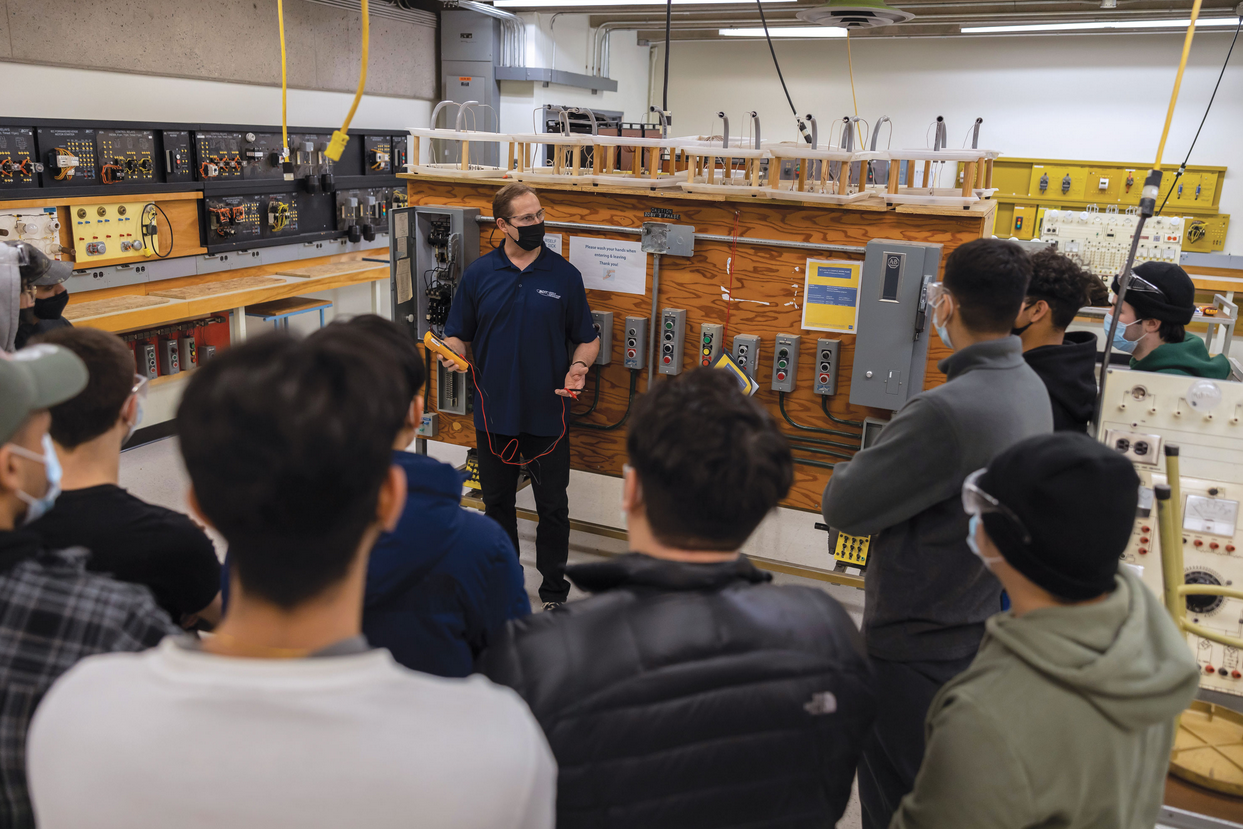Safety spotlight: Uniting safety training with technology
Teachers through BCIT's trades programs offer safety training, orientation, and supervision with a technological twist.
Getting into the safety mindset
Like many workplaces, BCIT’s Joinery Foundation class starts every day with a toolbox talk. This is where students read and sign safety protocols before operating any equipment. Instructor Andrew Pavle then opens up the floor to a Q&A before students go to their workstations. For Pavle, talking about safety is a critical mindset to have before entering the workforce.
“When I instruct, it’s important that students hear the real stories and examples about workers getting hurt on the job so they don’t make the same mistakes and so they know that the risks are real. I often tell a personal story where a piece of wood flew off a table saw just like a bullet, damaging objects in its path and penetrating a leather chair.”
He’s not alone when it comes to putting that mindset front of mind. In the Piping Foundation program, the first three weeks of class are dedicated strictly to safety training theory. Only the students who pass the safety tests (minimum grade of 70 percent) can move to the floor — a standard for all of BCIT’s construction courses.
“One thing I learned from my safety training so far is that it’s better to ask for help from an instructor if we’re unsure of how to operate a piece of machinery than to try anything on the floor,” says student Michael Li.
Combining QR codes with classic safety signage and training
Once students are ready for hands-on learning, technology allows for safety training at their fingertips. At the entrance to each shop, students can easily access a virtual tour via QR codes to help familiarize themselves with their space and specific areas of the room, which include safety protocols, emergency exits, and more.
Each piece of machinery also has a QR code that students can scan to take on-the-spot safety training without having to leave their station. What makes the QR code different from just posting the instructions, is that it links to videos on how to operate safeguards correctly so students can see examples of the machine in work and in lockout.
Using technology for training is extremely useful, but it’s meant to be a follow up to hands-on training, and ongoing supervision — not every workplace can safely allow phones and other devices on the shop floor. Each trade has a 16:1 student/instructor ratio, ensuring there is a mentor nearby at all times. Open communication between instructors and students is also supported and encouraged. Before moving on to the individual work stations, instructors demonstrate procedures and open up the floor to questions.
BCIT also uses traditional signage at entrances, and throughout all the shops, giving clear instructions for students and instructors alike to help ensure a safe learning environment. Each shop is equipped with floor decals marking work zones and signage around PPE requirements.
Understanding the purpose of de-energizing and lockout
To prepare his students for the real world, Pavle uses learner-focused teaching methods when training his students on locking out and de-energizing machinery.
“Our machines are equipped with the highest standard of safety features — such as lockout switches on equipment,” says Pavle. “To prepare students for a real-world scenario where they may be dealing with older or different equipment, we teach them the ultimate safety measure — to unplug the equipment to ensure their safety.”
The teaching staff also don’t shy away from sharing real-life scenarios of things gone wrong. “A common mistake I would see at the mill was for a worker to lock the machine door without locking the switch,” says Allen Emes, an instructor for the Electrical Trades programs. “Because you never know where these students will end up working, I try to give real examples of what I’ve seen in all types of fields … so they’re prepared for any situation.”
As a school, they are responsible to ensure that students know using equipment at the workplace isn’t going be a cookie-cutter experience. “One of the set-backs of using equipment with all of these safety features is that students could develop a false sense of security — so I ensure they’re mindful of other areas of the machinery that could be a safety hazard if they’re not paying attention,” adds Pavle.
Students learn from the industry experiences of their instructors and know that an injury could happen to anyone. On top of that, safety standards are always changing.
“Without this type of safety training, I would never have known about all the health and safety precautions that exist in the field,” says Shiori Ito, Joinery Foundations student and future young worker. “Because of the focus on safety training in the program, I feel confident that if I were to enter a workplace where safety protocols weren’t followed, I would recognize the hazards and would feel confident to speak up and refuse unsafe work.”
For more information
Viist worksafebc.com/youngworkers where you can find out more and view the following resources:
- Training and orientation for young and new workers
- Young and new worker orientation checklist
- Staying safe at work - a guide for people who are new to Canada
Check out BCIT's YouTube page for tips on creating your own training vidoes, health and safety tips, and more.
This information originally appeared in the May/June 2022 issue of WorkSafe Magazine. To read more or to subscribe, visit WorkSafe Magazine.

